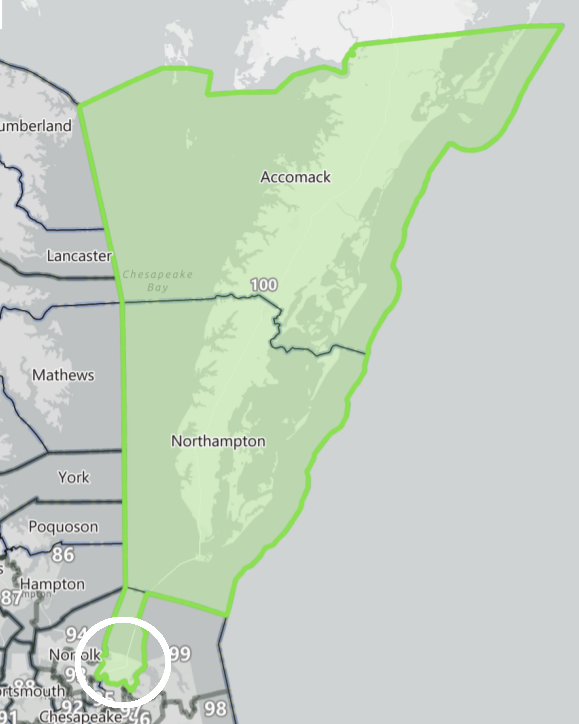
in 2021 the Eastern Shore lacked enough people, so a small portion of Virginia Beach was included in the 100th House of Delegates District proposed by two Special Masters
Source: Supreme Court of Virginia, House of Delegates:SCV

in 2021 the Eastern Shore lacked enough people, so a small portion of Virginia Beach was included in the 100th House of Delegates District proposed by two Special Masters
Source: Supreme Court of Virginia, House of Delegates:SCV
Virginia's first attempt to have a bipartisan redistricting commission negotiate a deal ended in failure. It did provide a more-transparent process, but in the end the Supreme Court of Virginia was tasked with drawing 151 maps for 11 members of Congress and 140 members of the state legislature.
Having the Supreme Court of Virginia draw the maps removed all the state legislators from the decision process. The General Assembly did not get a chance to vote on the Virginia Redistricting Commission's proposals. All members of the General Assembly, not just the eight legislators on the Virginia Redistricting Commission, lost their opportunity to pick their voters for the next decade.
The Supreme Court of Virginia was expected to consider the addresses of incumbents, and to minimize the number of new districts which might force incumbents to run against each other, but the judges had wide latitude on where to draw the lines. The refusal of the Republican members of the redistricting commission to negotiate a last-minute deal on October 8, or later on October 20 for Congressional districts, may have reflected an assumption that court-drawn district boundaries would minimize political impacts on incumbents.
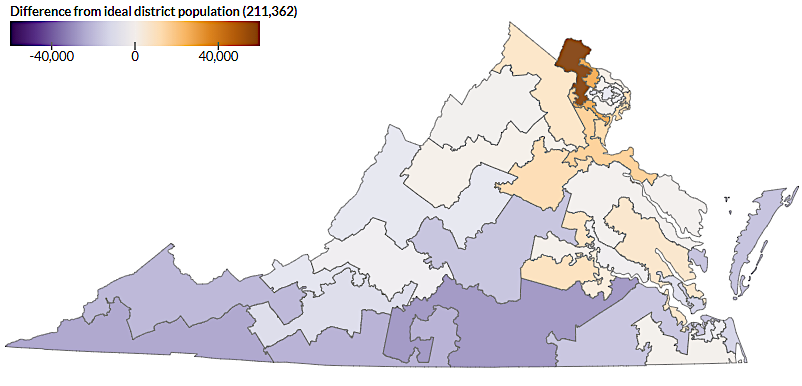
population changes in State Senate districts between 2010-2020 had to be smoothed out in the 2021 redistricting
Source: Virginia Public Access Project (VPAP), Winners, Losers in Redistricting
Since all the Supreme Court of Virginia judges had been elected when the General Assembly was controlled by Republicans, there may have been a greater willingness by the Republican members to block the commission from completing its task. The fall-back option added to the state constitution in 2020 did not require the judges to consider any of the 41 proposals developed by the commission.
Unlike the Virginia Redistricting Commission, the process used by the Supreme Court of Virginia was required by state law to begin with two "Special Masters." The judges were required to select one from a list of three redistricting specialists proposed by Democratic leaders in the General Assembly, and one from a list of three proposed by Republican leaders.
The judges directed the two Special Masters to negotiate a compromise between their interests. They had to create three unified maps, one for 100 House of Delegates district boundaries, one for 40 State Senate boundaries, and one for 11 US House of Representatives boundaries. The discussions by the judges to the map drawers, and among themselves during their consideration of draft maps, was not required to be in public. The court's decision process did not require the transparency which the 2020 constitutional amendment imposed upon members of the Virginia Redistricting Commission.
The boundaries created by the Virginia Redistricting Commission had no impact on the 2021 elections for the House of Delegates or House of Representatives. Because the Census data was delayed, the 2021 elections were based on the boundaries defined in 2011 plus changes made by Federal courts in 2016 for House of Representatives districts and in 2019 for House of Delegates districts.
A panel of three Federal judges had ruled in Personhuballah v. Alcorn (2012) that the Third District for the House of Representatives had been "packed" with an unconstitutionally-high percentage of African Americans. The Federal court finally established new lines in 2016 that lowered the percentage of African Americans in the Third District by 11%, and raised the percentage in the nearby Fourth District by nearly 10%. The edges of the Seventh and First Congressional districts were also revised slightly.
The U.S. District Court for the Eastern District of Virginia determined in Bethune-Hill v. Virginia Board of Elections (2018) that boundaries of 11 House of Delegates districts had been unconstitutionally gerrymandered in 2011 based on to race. After the General Assembly failed to adopt a new map, the court imposed new boundaries that affected 26 districts.1
In 2021, candidates ran for office based on those 2019 district lines. The 2020 Census had revealed that Virginia's population had grown by 7.9% to 8,631,393 people, but there was no time to adjust the election district boundaries in time for the 2021 elections. The increase of over 630,000 people since 2010 was not evenly spread across the state, so the boundaries did not meet the "one person, one vote" standard.
In Northern Virginia, House District 87 had 130,221 residents. In Southside, House District 75 had only 67,985 residents.
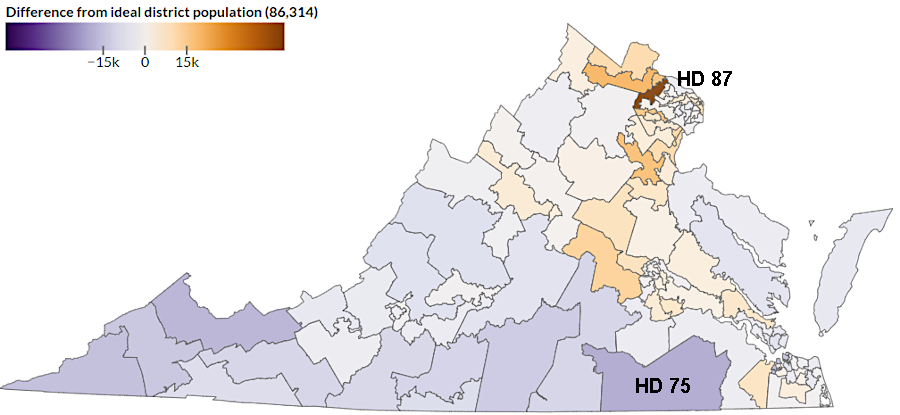
brown shows House of Delegates districts with too many voters in 2021; grey shows districts with too few voters
Source: Virginia Public Access Project, Gainers, Losers in Redistricting
The Virginia Public Access Project identified the ideal number of people per district:2
New Jersey had the same problem. Voters there approved a constitutional amendment that allowed officials elected in 2021 to serve a full term, but in Virginia it was unclear if a new election would be required for House of Delegates in 2021. The former head of the Democratic Party in Virginia filed a lawsuit to force a new election, as was required in 1981 when that year's redistricting was ruled unconstitutional.
The Virginia Attorney General tried to block the lawsuit, claiming the Virginia Board of Elections had immunity from being sued in a Federal court. The Attorney General also declined to issue an official opinion on the need for new elections in 2022 to reflect one person-one vote boundaries. The 2021 election was based on district boundaries which were 40,000 people above the median and 10,000 people below.
The Federal judge suggested that the Attorney General could eliminate the need for the lawsuit if he "did his job" and issued an opinion, then scheduled the next hearing for a date after the November 2021 election. The incumbent Attorney General Mark Herring was defeated in his bid for re-election to a third consecutive four-year term, but he did not alter his objections to the lawsuit.
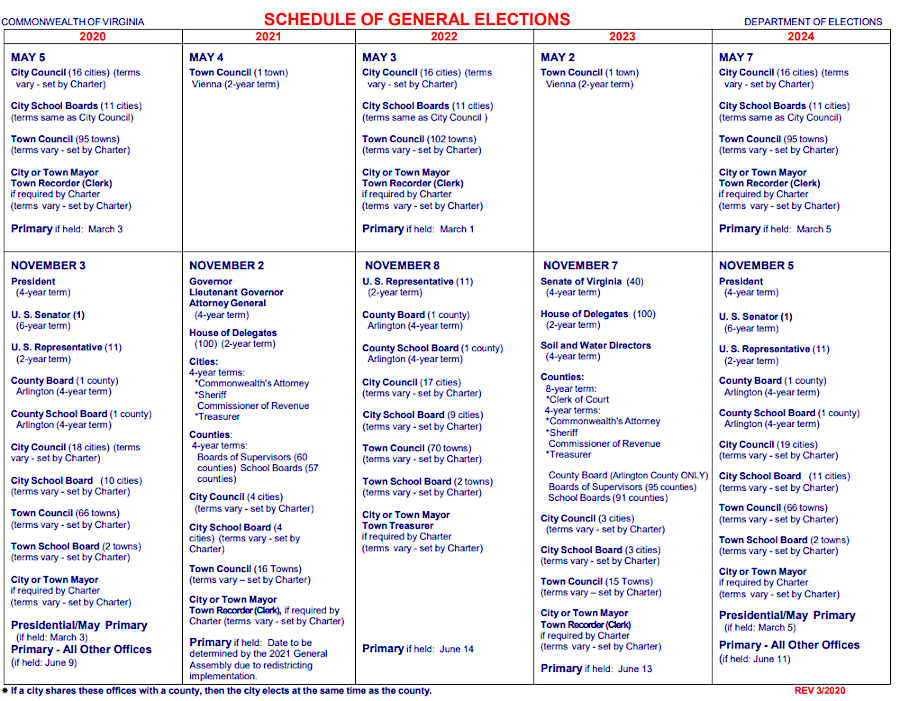
before the 2020 Census results were delayed, Virginia had no plans for House of Delegates elections in 2022
Source: Virginia Department of Elections, 5-Year Schedule of General Elections
One reason for the Attorney General to delay is that the impact of redistricting on elections in 2022 was unknown, because new district boundaries had not been adopted after the 2020 Census. Official Republican and Democratic leaders did not join the lawsuit before the 2021 election:3
Before the scheduled hearing, the judge selected two more Federal judges to create a three-judge panel, a requirement for making decisions on constitutional challenges regarding legislative apportionment.4
Republicans swept the 2021 statewide elections, winning the offices of Governor, Lieutenant Governor, and Attorney General. They also gained control of the House of Delegates with a 52-48 majority.
Because the new Virginia Redistricting Commission had failed to draft new boundaries before its October 10, 2021 deadline, the Supreme Court of Virginia was forced to adopt redistricting maps. Delays due to potential appeals to the Federal lawsuit could result in that redistricting being completed before the final hearing on the lawsuit, so the potential for Republican/Democratic victories in 100 House of Delegates districts in the next election would become clear. In that scenario, the three Federal judges would be aware of the odds that their decision on the lawsuit might flip the partisan control of that chamber in an out-of-cycle 2022 election.
If the panel determined that a new election was *not* required in 2022 using new boundaries, then members of the House of Delegates elected in 2021 would serve a full two-year term. The alternative was for the panel to require new elections using new district boundaries based on the 2020 Census, boundaries that would meet the "one person, one vote" standard. As political expert Larry Sabato described the choice:5
The November 2, 2021 election altered the growing perspective that Virginia was a "blue" state. Republican victories complicated the burden on the Supreme Court of Virginia, which had to adopt redistricting maps that would acknowledge Virginia as a "purple" state and not favor the Democrats. State law required that:6
After the Virginia Redistricting Commission failed to adopt any proposed maps, the Supreme Court of Virginia had to select "special masters" to draw proposed maps. Republicans proposed three redistricting experts known for close ties to the party, while Democratic officials in the General Assembly proposed three college professors. When the Democrats asked the judges to disqualify the Republican nominees as excessively partisan, Republicans responded with:7
The court did decide to reject all three Republican nominees due to conflict on interest concerns in a unanimous decision, and directed legislative leaders to submit new nominations. The judges also rejected one Democratic nominee, indicating that nominee had identified conditions under which they could not serve as Special Master. The court also declared that the two mappers which would be selected, one from each political party's nominations, should not draw districts based on partisan perspective.
The Special Masters were directed to serve in a quasi-judicial capacity, not as dueling partisan advocates. According to the Code of Virginia:8
The Special Masters benefitted from public comments submitted before they presented their recommendations. One submission proposed creating a likely Democratic House of Delegates district in otherwise-Republican Southside by placing Martinsville and Danville in the same district. In the proposed district, 49% of the population would be "Black alone or in combination." Combining Lynchburg into one district, rather than keeping it split between two House of Delegates districts and two state Senate districts, would also enhance the potential for a Democratic victory.
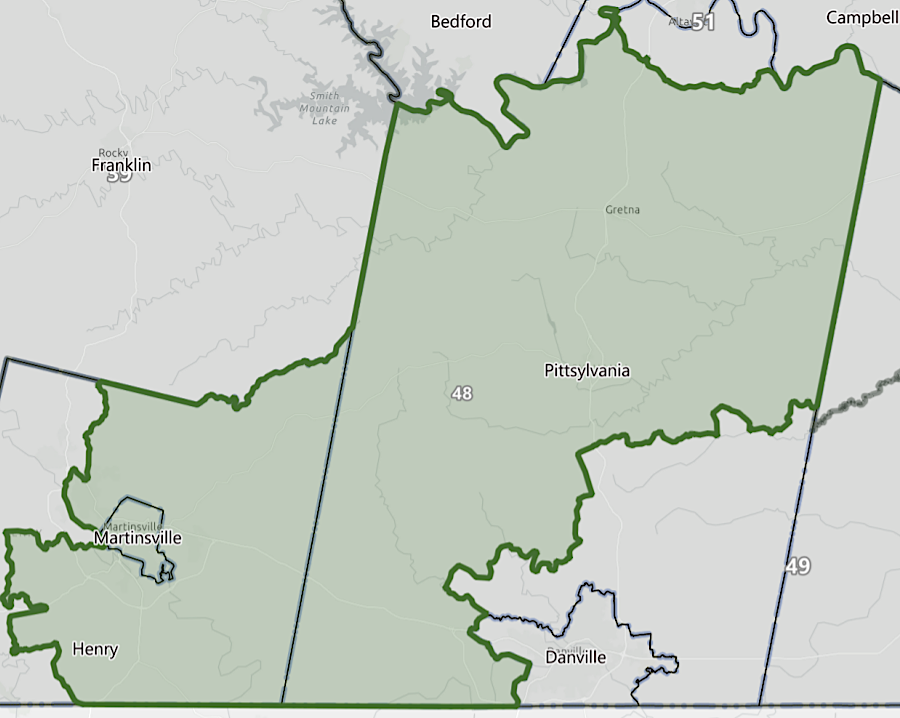
the Special Masters appointed by the Supreme Court of Virginia proposed a House of Delegates 48th District that did not combine Martinsville and Danville
Source: Supreme Court of Virginia, House of Delegates:SCV
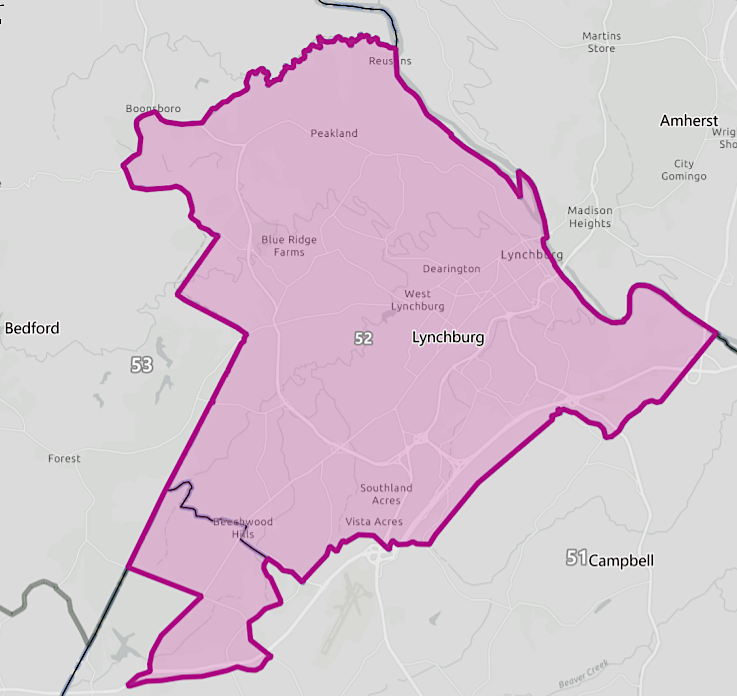
the Special Masters placed all of Lynchburg in the 48th House of Delegates District
Source: Supreme Court of Virginia, House of Delegates:SCV
It was also clear to the Special Masters that Democrats would benefit from a map that placed Albemarle County and Charlottesville in just two House of Delegates districts, rather than fragmenting those jurisdictions into four districts with a majority of rural residents who voted for Republicans. If the court prioritized "community of interest" over "compact and contiguous," it could also draw a General Assembly district combining Roanoke, Radford, and Blacksburg. Those three communities were more closely aligned in political support for Democrats than they were closely located together physically.9
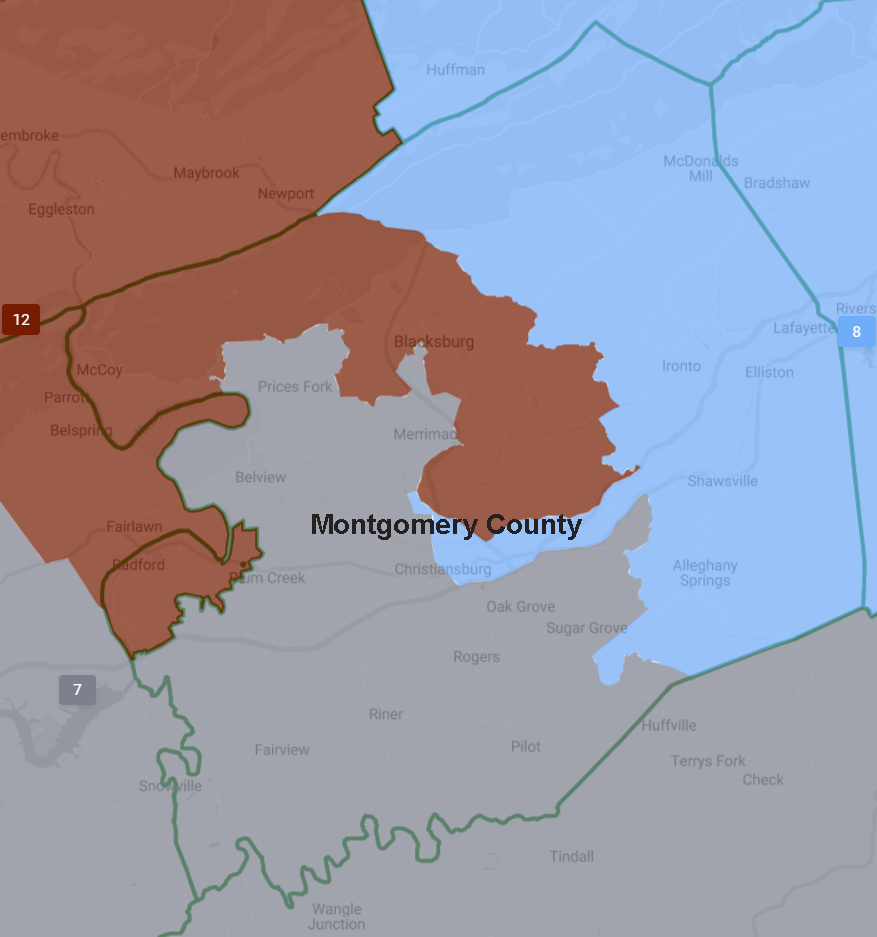
before the redistricting after the 2020 Census, Montgomery County was divided among three House of Delegates districts
Source: Virginia Redistricting Commission, Current Districts enacted between 2011 & 2020
One resident of Charlottesville, evidently a Democratic voter frustrated by inclusion in the 5th Congressional District where Republican candidates won repeatedly, told the Supreme Court of Virginia:10
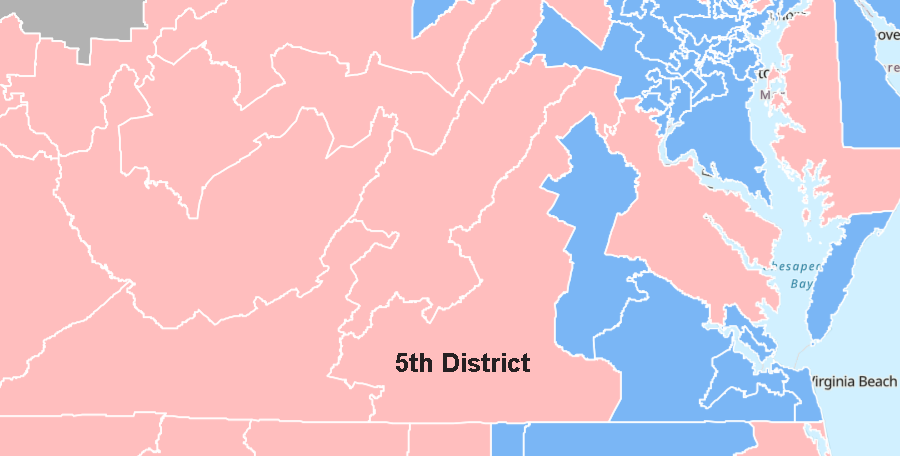
before the redistricting after the 2020 Census, the Fifth District for US House of Representatives stretched from Fauquier County to North Carolina and included primarily rural areas
Source: ESRI, ArcGIS Online
Dwayne Yancey, editor of Cardinal News, assessed the potential for creating a US House of Representatives district which included Charlottesville and Albemarle County and might elect a Democratic candidate to Congress. The fundamental challenge was that the population of Charlottesville and Albemarle County was only 21% of the number of people that had to be included within a Congressional District. To create a compact a contiguous district, the surrounding counties would need to be added to provide the other 79% of the voters - and the rural counties near Charlottesville/Albemarle were dominated by Republican voters.
The court could draw district lines parallel to I-64 in order to link Charlottesville/Albemarle County to western Henrico County and Richmond, defining "community of interest" by the political preference for electing Democrats. Such a boundary would be a clear political gerrymander, however.
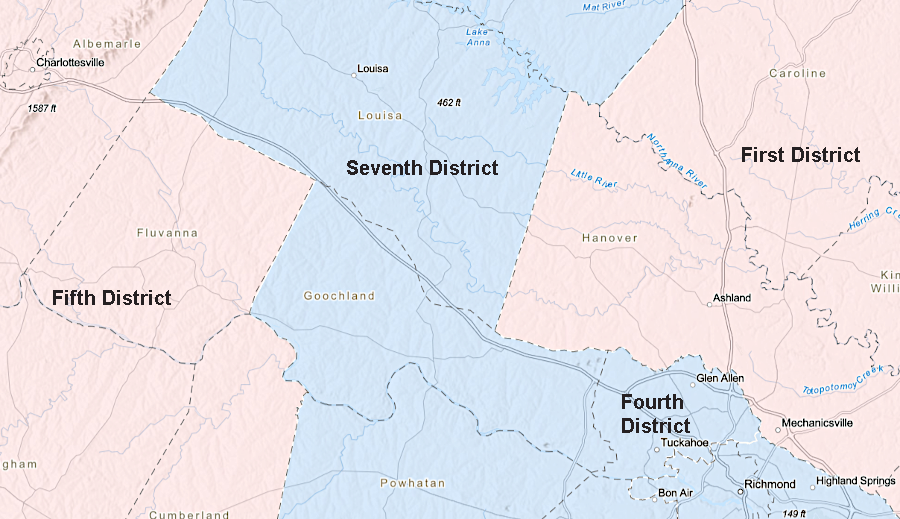
a Fifth District gerrymander based on political priorities could combine Charlottesville and Albemarle County with Democratic-leaning portions of Henrico County
Source: ESRI, ArcGIS Online
The Cardinal News editor stated bluntly:11
The Special Masters appointed by the Supreme Court of Virginia delivered their recommendations in early December as one proposed map for the House of Delegates, State Senate, and US House of Representatives. The two Special Masters had few disagreements on where to draw new boundaries. Most significantly, they did not submit separate partisan maps and force the court to choose between a Democratic and Republican proposal, which would have exposed the judges to charges of partisan bias:12
The process started with defining the 11 US House of Representatives districts. The Special Masters then tried to draw boundaries of the 40 State Senate districts within the boundaries of the 11 Congressional districts, and finally to "nest" the 100 House of Delegates districts within the boundaries of the State Senate districts.
The two Special Masters jointly proposed fewer minority-majority districts than the existing map. They argued that it was more important to create districts where minority groups would have the ability to elect their candidates of choice, and there were more such districts in thei 2021 proposal. Their report to the Supreme Court of Virginia explained how they drew boundaries for districts in which candidates of a minority race would be competitive, while the racial composition of the districts was not the dominant factor shaping their decisions:13
The proposed map prioritized compactness rather than partisan balance. The boundaries were not drawn to create 50% Republican districts and 50% Democratic districts. Democrats were pleased to see General Assembly district boundaries that were projected to produce a 23-to-17 majority in the State Senate and a 53-to-47 majority in the House of Delegates.
The US House of Representatives map proposed by the Special Masters split Albemarle County between the Fifth and Tenth Congressional Districts.
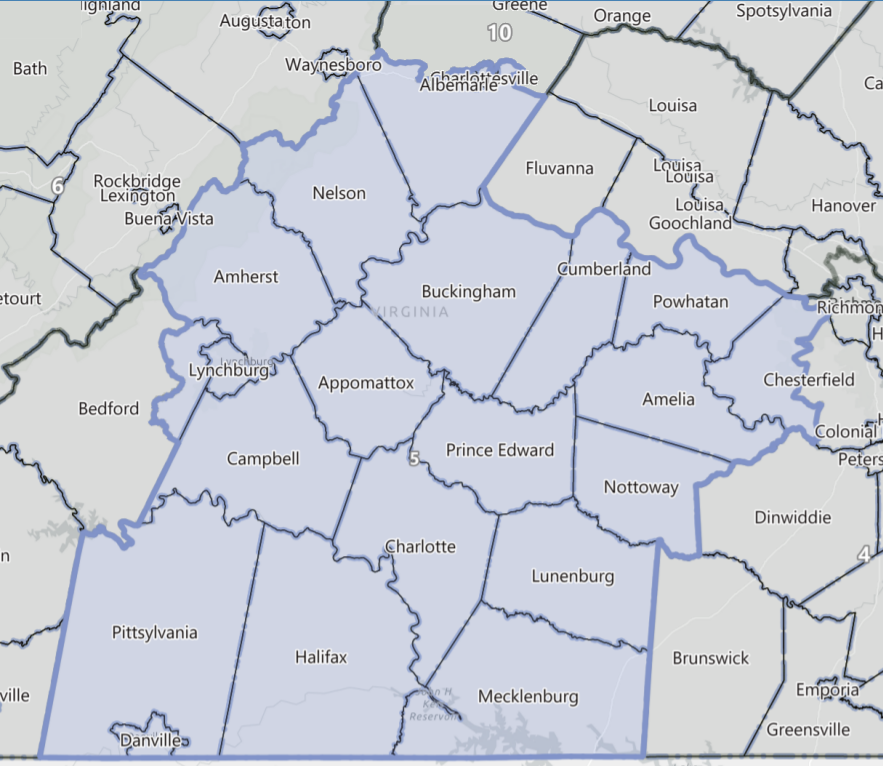
the Special Masters proposed a Fifth District (shaded blue) that included half of Albemarle County, with the remainder in the Tenth District
Source: Supreme Court of Virginia, Congressional:SCV Draft 1
The Special Masters used the eight regions identified by the University of Virginia's Weldon Cooper Center. However, they noted that the Blue Ridge was a geographic boundary that should be taken into consideration, even though three regional boundaries on the Weldon Cooper Center map crossed the mountains:14
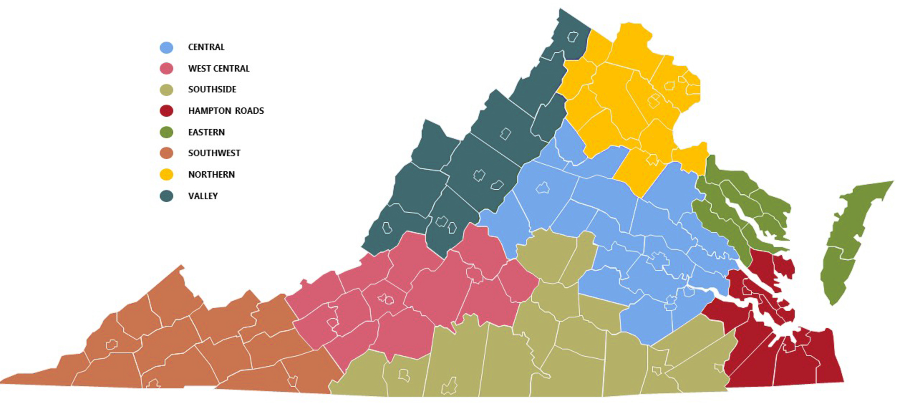
the Special Masters used the Blue Ridge as a boundary, in contrast to the regional boundaries defined by the Weldon Cooper Center
Source: University of Virginia Weldon Cooper Center, Virginia's Demographic Regions
The Special Masters proposed new boundaries for the Sixth and Tenth Congressional Districts that used the Blue Ridge as a boundary. Their map left the Ninth District as the only one with counties on both sides of the mountains.
As described in Cardinal News, one of the Congressional Districts had to incorporate territory on both sides of the Blue Ridge:15
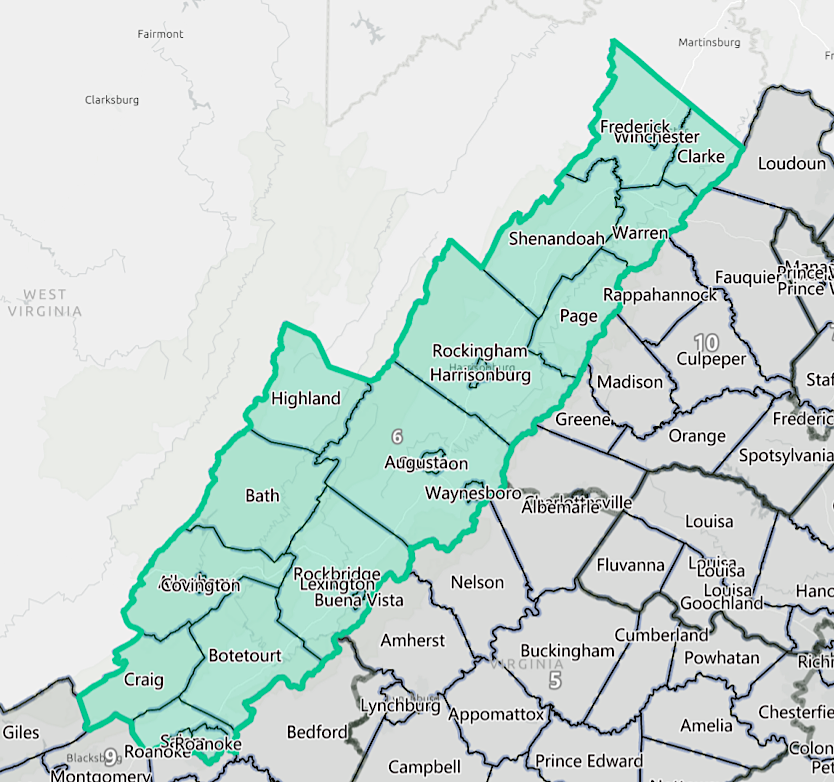
the Sixth Congressional District would be west of the Blue Ridge, adding Frederick and Clarke counties while dropping Amherst, Lynchburg, and part of Bedford County
Source: Supreme Court of Virginia, Congressional:SCV Draft 1
For the 11 US House of Representatives districts, the most dramatic revision was in the Seventh District. The boundaries were moved north to focus on Stafford and Prince William counties. Prince William had been split among three Congressional districts, the First, Tenth, and Eleventh.
The initial maps presented by the Special Masters put 24 Republican and 22 Democrats in the 100-member House of Delegates into districts with two or more incumbents, and created 24 districts with no incumbent. Half of the 40 members in the State Senate were placed in a district with another incumbent, and 12 districts would be "open seats." Had the voters rejeced the constitutional amendment and let the legislators draw the maps, or had the Virginia Redistricting Commission drawn the maps, only a tiny percentage of districts would have been open seats.
The Special Masters indicated that they intentionally did not take into consideration the home addresses of incumbents when drafting the maps:16
The incumbent in the Seventh District, Rep. Abigail Spanberger, lived 50 miles outside of the proposed district boundaries. The Seventh District was proposed as an "open seat," with no incumbent member for the 2022 race.
The incumbents in the Sixth and Ninth District of the US House of Representatives both lived within the proposed boundaries of the Sixth District. The maps proposed by the Special Masters would make the Ninth District another open seat unless the Supreme Court of Virginia used its authority to revise the draft lines.
Rep. Morgan Griffith was elected to the US Congress in 2010 when he did not live within the Ninth District, though the redistricting after the 2010 Census was able to adjust the boundary. He could choose to move from Salem to become a resident within the new boundaries of his Ninth District, but there is no requirement for a US Representative to live within his or her district.
At the Congressional level, Sabato's Crystal Ball concluded that the Special Masters:17
Efforts to analyze the political impact were hampered by the high percentage of absentee voting in recent elections. Except in Amherst, Campbell, Fairfax, and Floyd counties and the City of Chesapeake, absentee votes in 2021 were tabulated together in one Central Absentee Districts for each jurisdiction. The Special Masters used the 2017 race for Attorney General to assess the partisan impact of the proposed new boundaries.18
To assess the detailed geography of political preference, based on the record of voting in individual precincts, the Virginia Public Access Project (VPAP) used the 2016 Presidential Results.
According to the Virginia Public Access Project, there was no change in the competitiveness of the 11 US House of Representatives seats, with five listed as Strong/Leans Democratic and five listed as Strong/Leans Republican. The Virginia Public Access Project calculated that 10 House of Delegates seats would be competitive, with 49 rated as Strong/Leans Democratic and 41 evaluated as Strong/Leans Republican. The primary change was that the current map rated 30 seats as Strong Democratic while the proposed map rated 38 seats as Strong Democratic. The competitiveness of the State Senate races would be only marginally affected by the Special Masters map , with just one seat shifting from Competitive to Strong Democratic.
The Special Masters used different math, based on their use of the 2017 Attorney General race to evaluate partisan competitiveness. The Special Masters projected that for the State Senate the new district boundaries created 23 Democratic districts and 17 Republican ones, but four (10% of the State Senate) were competitive for both parties:19
The Princeton Gerrymandering Project concluded that the Special Masters created 24 State Senate districts and 58 seats in the House of Delegates favorable to Democrats, so they would have a majority in the General Assembly.20
The Supreme Court of Virginia scheduled time in December for public review of the draft maps proposed by the Special Masters. The Special Masters used the public comments to identify where they should modify all three of their initial maps. Their revisions were accepted by the court and a unanimous decision by the judges resulted in final maps being released just after Christmas, 2021 for House of Delegates, State Senate, and US House of Representatives.
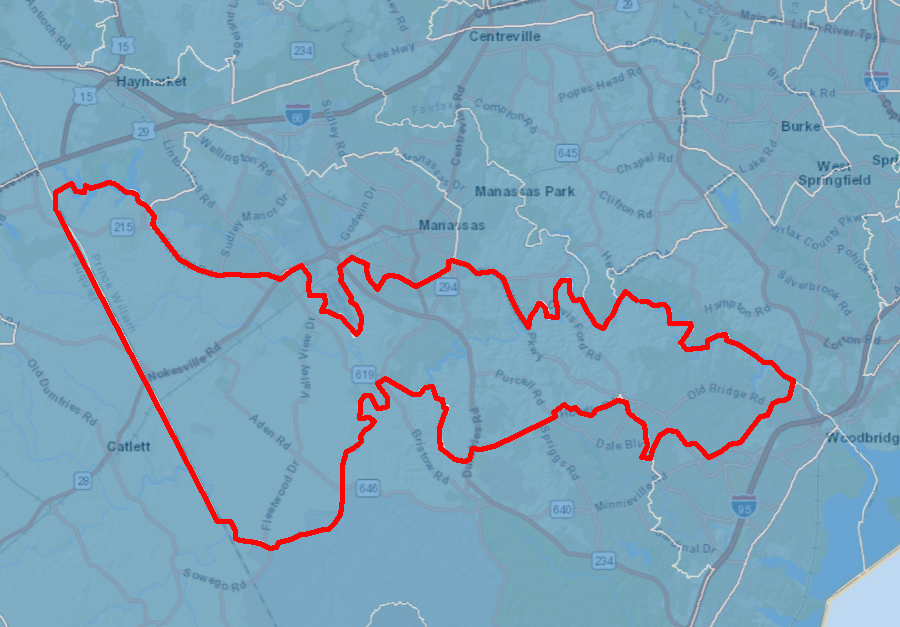
51st House of Delegates district boundaries before 2021 redistricting
Source: Virginia Department of Transportation (VDOT), Virginia Roads
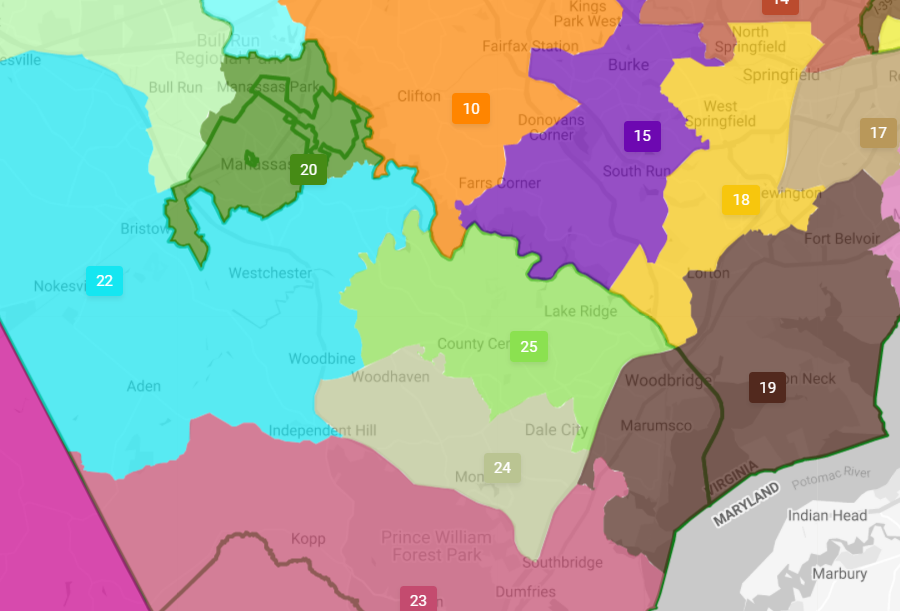
House of Delegates boundaries after final 2021 redistricting were more compact and contiguous
Source: Supreme Court of Virginia, SCV Final House of Delegates Map (interactive)
Much of the public comment on the draft maps focused on how incumbents were affected by new boundaries. The Special Masters response was that they focused on combining communities of interest defined in part by Census Designated Places and jurisdictional boundaries, and protection of incumbents was not included within the Statutory Criteria that guided their process:21
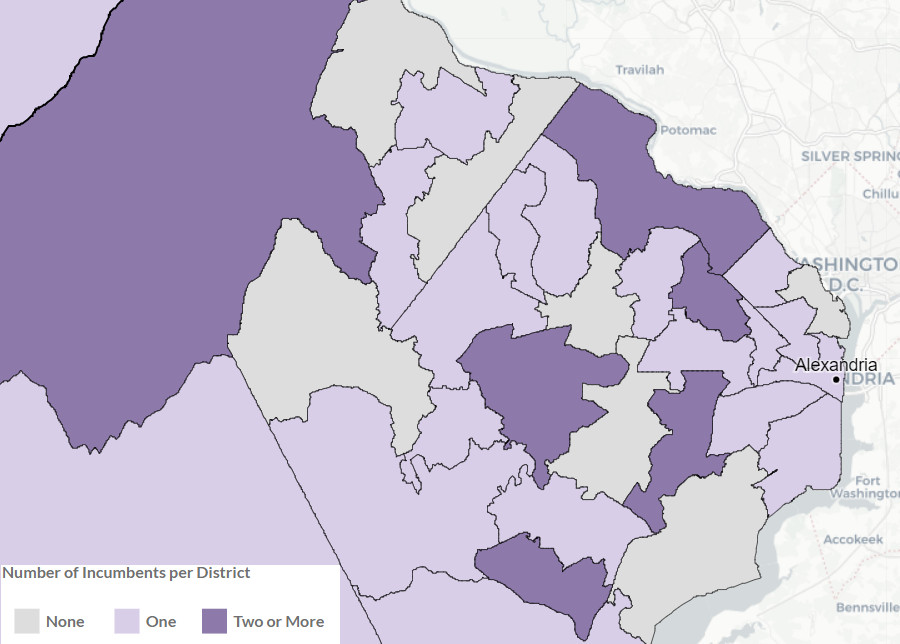
in Northern Viginia, six of the new House of Delegates districts had two incumbents living with the boundaries while seven of the new districts had no incumbent
Source: Virginia Public Access Project, Approved - Va Supreme Court Special Masters
The Special Masters did not consider it to be their job to draw boundaries that would create competitive districts, except to ensure "ability-to-elect districts" would be able to elect the minority candidate of choice. Three members of the US House of Representative ended up living outside the boundaries of their districts, though Rep. Elaine Luria in the Second District owned another home within the new boundaries.
The Virginia Supreme Court created the first incumbent-blind redistricting in the state's history. Even the initial creation of US House of Representatives districts in 1788 may have been shaped by the efforts of Patrick Henry to limit the potential of James Madison to be elected. Claiming the "Herrymander" was the first atttempt to gerrymander Virginia's electoral boundaries may overstate the case, but until 2021 the legislators used their influence to shape most new district boundaries.
In contrast, the 2021 redistricting defined the boundaries of 40 State Senate and 100 House of Delegates districts without prioritizing the safe election of the most-powerful incumbents. In the State Senate, 20 incumbents ended up living in districts with another incumbent. 50% of the State Senate districts ended up as "open," with no incumbent living within the boundaries.
In the House of Delegates, 44 of the 100 members were placed within a district with another incumbent. No previous court-based redistricting, theoretically independent processes with less concern for incumbent protection, had created so many opportunities for challengers to replace incumbents.
The Virginia Redistricting Commission would not have created so many districts that forced incumbents to retire, move, or run against each other. Had the legislators and citizen members of the commission found a way to cooperate in 2021, judges in a separate branch of government would not have had the opportunity to draw the boundaries of election districts. The partisan deadlock in the 2021 redistricting process ended up damaging the re-election hopes of incumbent legislators in both the Republican and the Democratic parties.
Notably, three members of the General Assembly who had served on the Virginia Redistricting Commission were placed in new districts with another incumbent. Had those elected officials and other members of the Virginia Redistricting Commission been able to adopt maps, the three members would have protected their re-election chances. Boundaries drawn by elected politicians would have been different; they would have ensured that the key elected politicians would not have to compete with another sitting legislator when running for re-election.
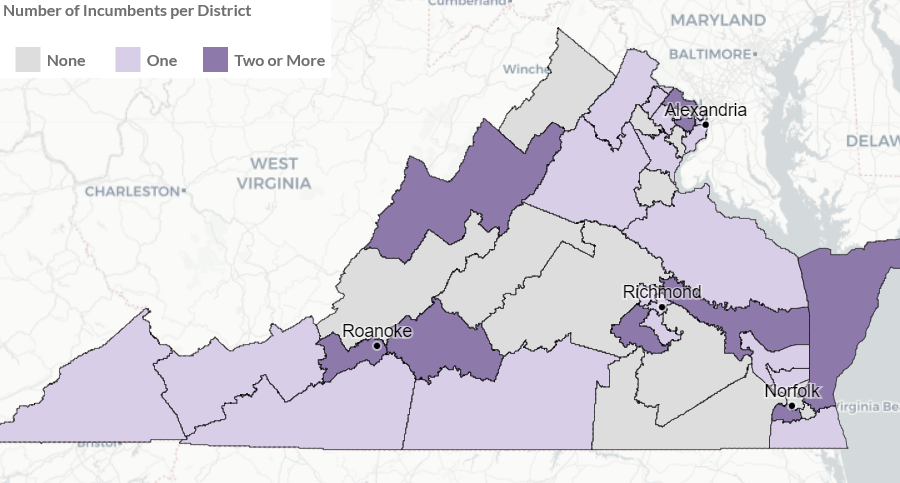
for the State Senate, incumbents were forced to run against each other and open seats were created in all regions except Southwest Virginia
Source: Virginia Public Access Project, Approved - Va Supreme Court Special Masters
The Special Masters chose to assess the partisan impacts only after drafting their boundaries. When making final revisions after public comment, the Special masters claimed they made only non-partisan changes to avoid being:22
The editor of Cardinal News assessed the final maps and concluded:23
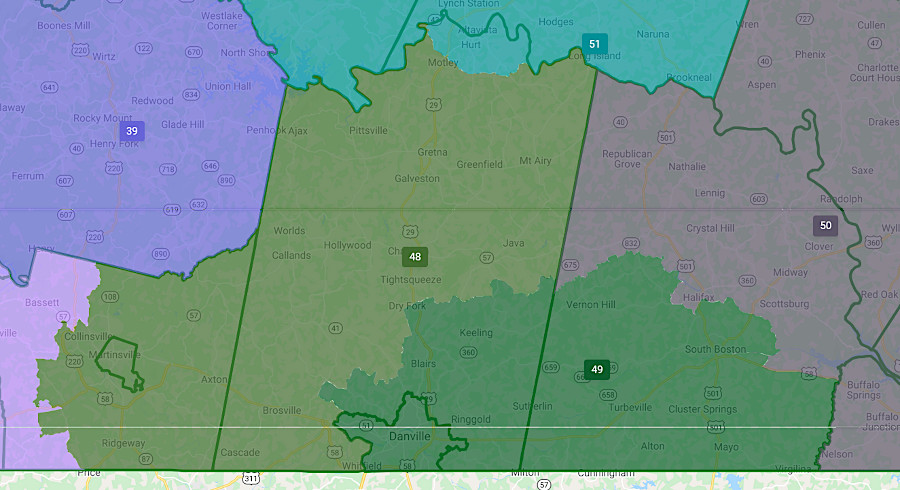
Danville and Martinsville were split between the 48th and 49th House of Delegates districts, reducing the potential to elect a Democrat in that part of Southside Virginia
Source: Supreme Court of Virginia, SCV Final House of Delegates Map (interactive)
Concerns about partisanship did affect revisions to the Seventh District for the US House of Representatives, which was altered the most between the draft proposal and the Supreme Court of Virginia's final decision. Revisions to the Fifth District moved Chesterfield County into the First District, combining it with Henrico County. Removing Chesterfield County from the First District left Richmond and its suburbs split between just two (Fourth and Seventh) rather than three Congressional districts.
Incumbent Rep. Abigail Spanberger's house in Henrico County was still left in the First District, so the Seventh District was an open seat. That created a cascade of decisions by politicians seeking election to the US Congress.
Based on the initial draft maps proposed by the Special Masters, State Senator Bryce Reeves had announced plans to run in the Tenth District. When the Supreme Court of Virginia revised the boundaries in the final map, his home ended up in the Seventh District. He switched his plans and announced that he would run for the Seventh District seat in 2022.
Theresa Ellis, a member of City Council in Manassas had originally announced her campaign for the Tenth District. After the Special Masters released their initial draft maps, she switched to campaign for the Seventh District, reflecting the shift of district boundaries where she lived. When the Supreme Court of Virginia placed her house back in the Tenth District, Ellis switched back to campaign for the Tenth District again.


the website for one candidate was quickly scrubbed of plans to run in the Seventh District after the Supreme Court of Virginia placed her back in the Tenth District
Source: Theresa Ellis for Congress, December 18 and December 29, 2021
Within a day of the announcement of the final redistricting maps, county supervisor Yesli Vega in Prince William County announced she too would run for the Seventh District nomination as a Republican.
Another supervisor in Prince William County, Jeanine Lawson, had previously announced plans to run for the Tenth District. She did not change her plans when the Special Masters proposed placing her house in the Seventh District. Revisions to initial proposal resulted in the final map placing her in the Tenth District, for which she continued to campaign.
In the end, Jeanine Lawson lost the Republican nomination for the Tenth District to a Loudoun County candidate, Hung Cao. He then lost in the November, 2022 general election. Yesli Vega won the Republican nomination for the Seventh District but lost in the general election to the Democratic candidate, Abigail Spanberger. Spanberger was the "incumbent," but had to win votes from many residents who previously were not in the Seventh District.24
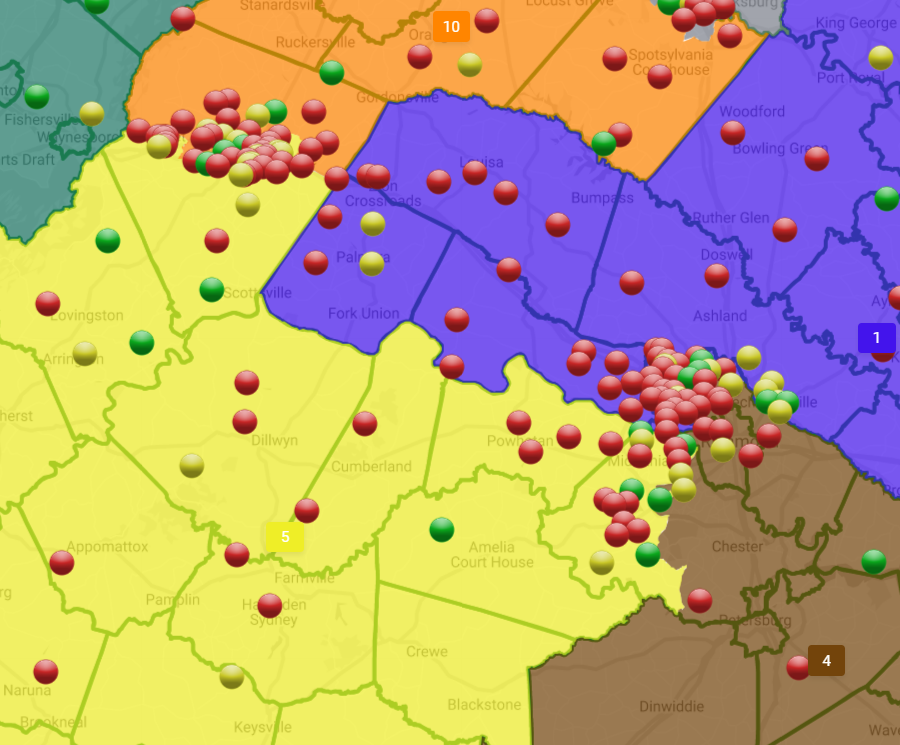
public comments on the first proposal from the Special Masters objected to placing the western half of Chesterfield County in the Fifth Congressional District and placing Louisa, Fluvanna, and Goochland counties in the Tenth Congressional District
Source: Supreme Court of Virginia, Special Masters Proposed Congressional District Map (interactive)
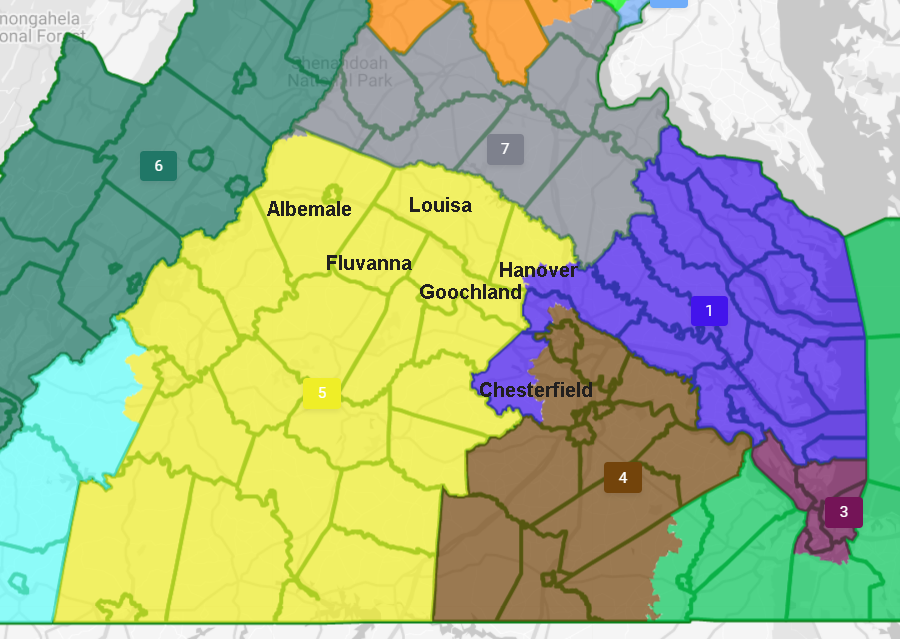
in the final map, Chesterfield County was moved to the First Congressional District and counties in the Piedmont were consolidated into the Fifth Congressional District
Source: Supreme Court of Virginia, SCV Final Congressional District Map (interactive)
To add population back onto the Fifth District, the Special Masters added Louisa, Fluvanna, and Goochland counties, which had in the draft proposal been included with Tidewater rather than other Piedmont jurisdictions. Northern Albemarle County was moved from the Tenth District into the Fifth District as well, consolidating with the rest of that county. Prince William County ended up getting split rather than Albemarle County:25
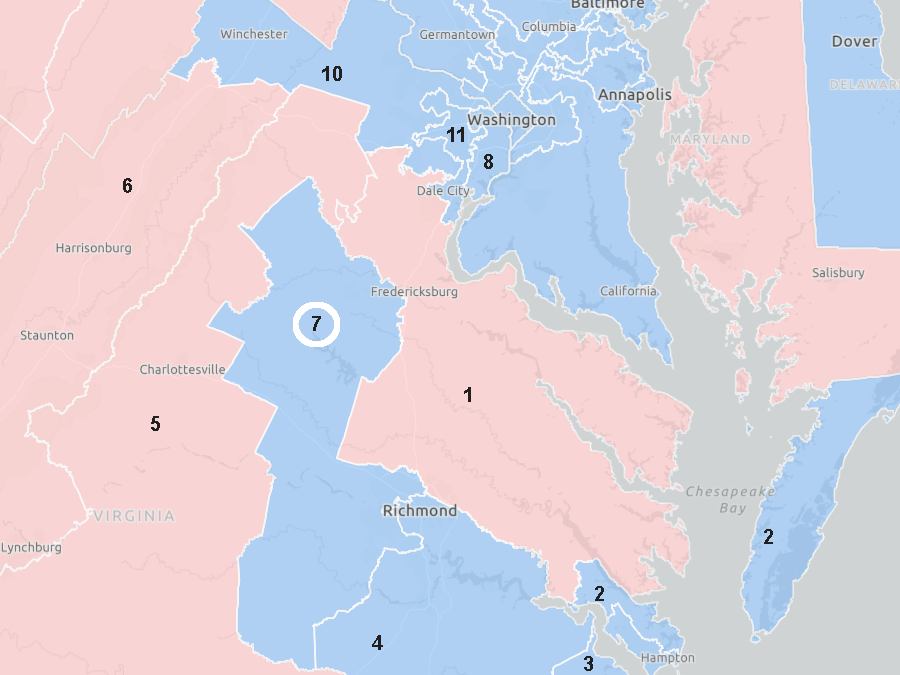
between 2011-2021, the Seventh Congressional District stretched from Culpeper to Nottoway counties west of Richmond
Source: ESRI, ArcGIS Online
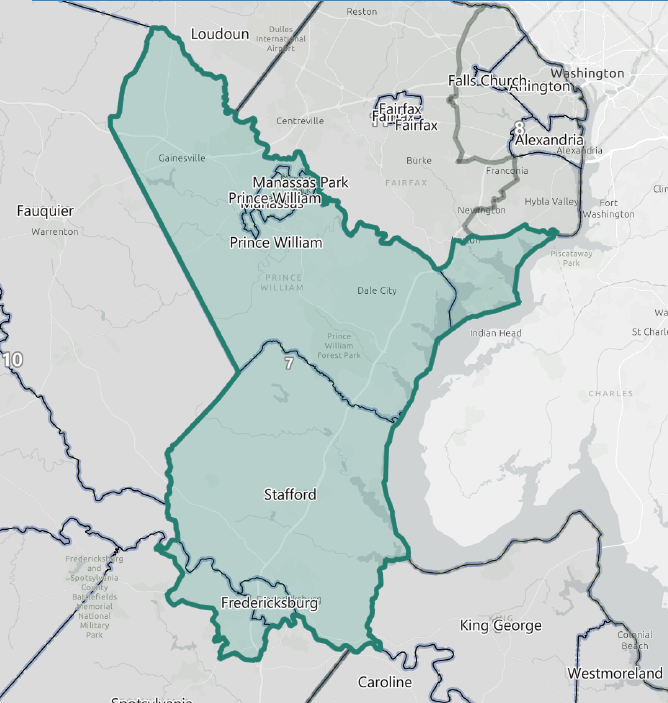
the most dramatic change in the 2021 redistricting proposed by the Special Masters was to locate the Seventh Congressional District in Northern Virginia
Source: Supreme Court of Virginia, Congressional:SCV Draft 1
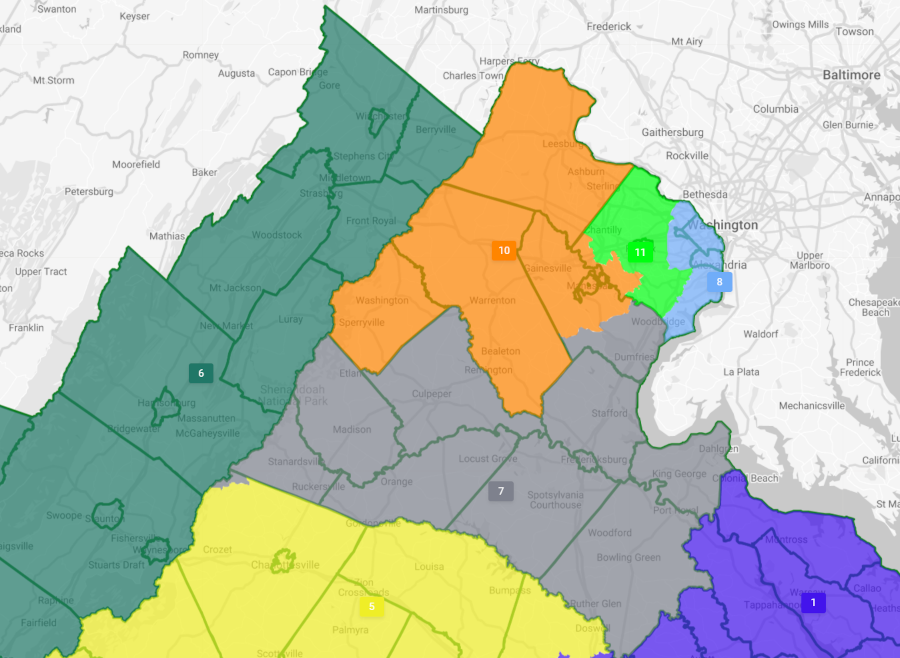
the final decision by the Supreme Court of Virginia revised the proposed Seventh District boundaries, splitting Prince William County with the Tenth District
Source: Supreme Court of Virginia, SCV Final Congressional District Map (interactive)
Concerns about making changes that would affect partisan results also caused the Special Masters to reject a request to modify a proposed State Senate district in Prince William County:26
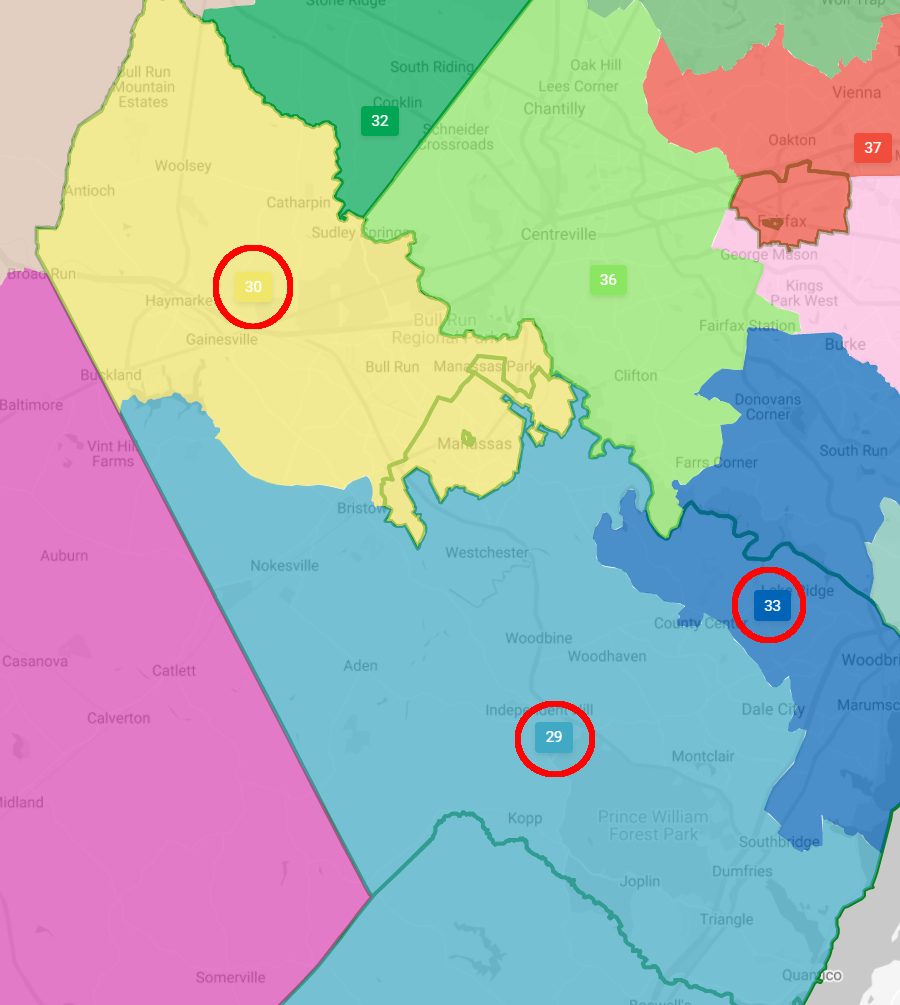
the final State Senate map placed all of Prince William County in three districts
Source: Supreme Court of Virginia, SCV Final State Senate Map (interactive)
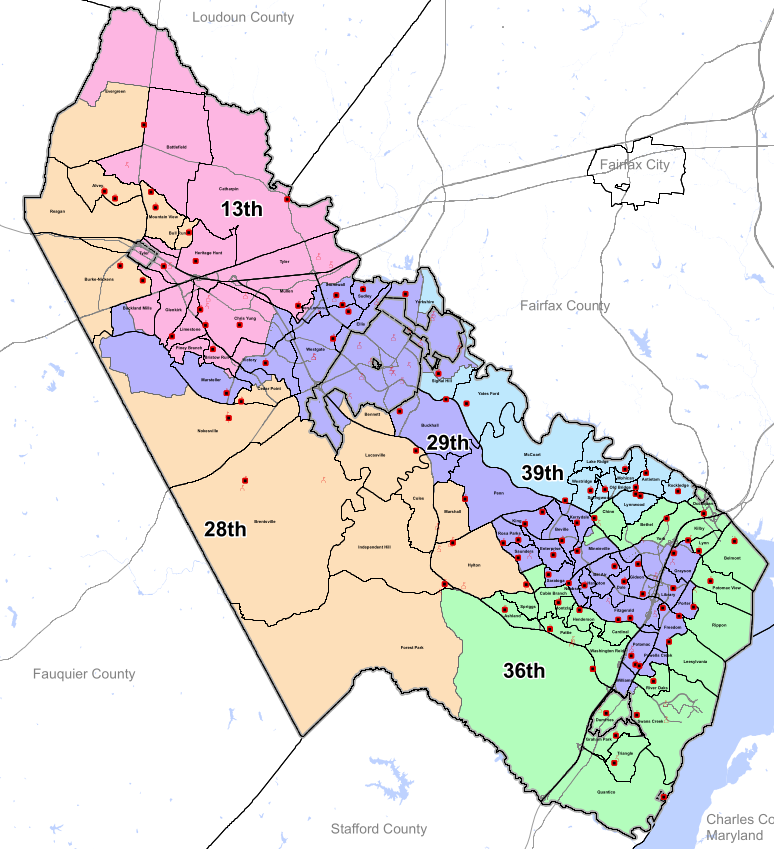
prior to the 2021 redistricting, Prince William County was fragmented into five State Senate districts
Source: Prince William County, Small VA Senate District Map_Layout
Public comments on the draft map proposed by the Special Masters caused them (and ultimately the Supreme Court of Virginia) to move the City of Falls Church out of districts with Arlington County and to consolidate with Fairfax County. That triggered a cascade of changes to the proposed map in Northern Virginia for State Senate and House of Delegates districts.
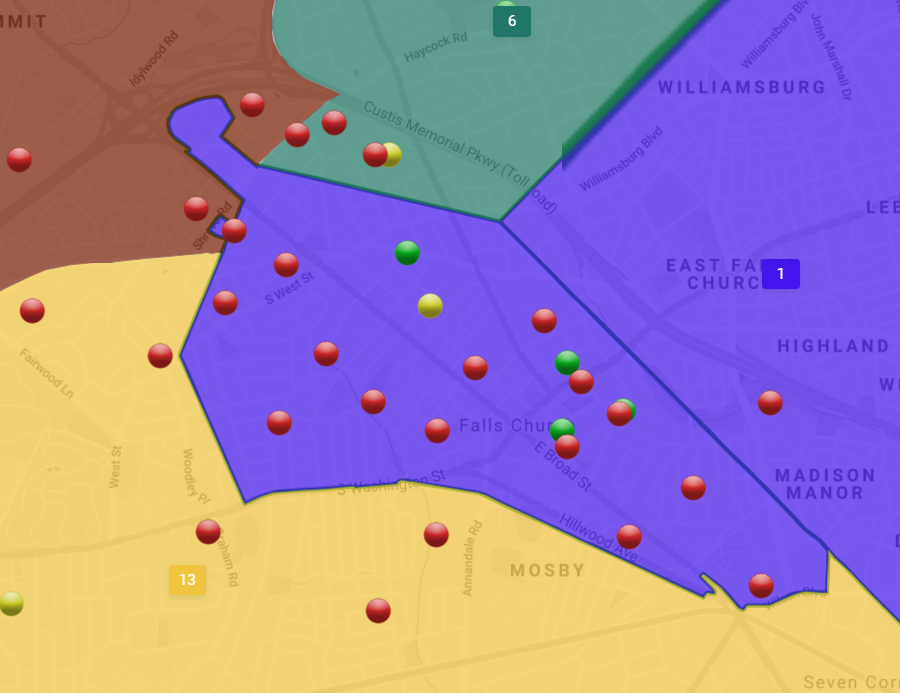
public comments objected to placing Falls Church with Arlington County for House of Delegates elections
Source: Supreme Court of Virginia, Special Masters Proposed House of Delegates Map (interactive)
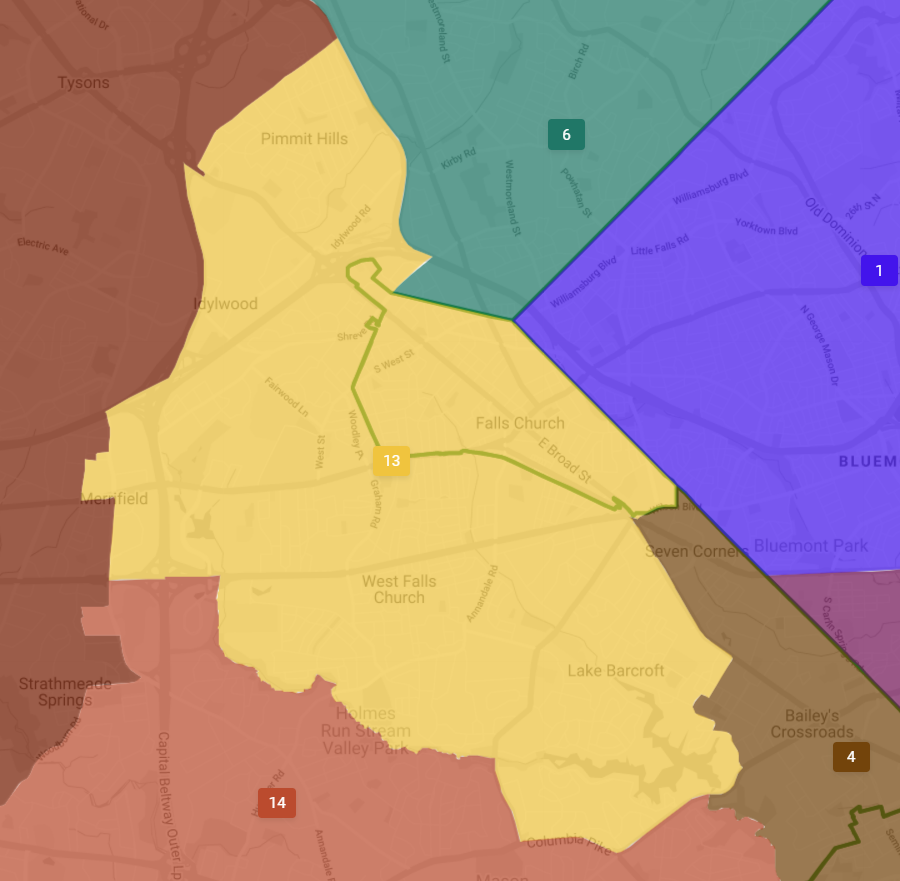
the final 2021 House of Delegates map placed Falls Church with Fairfax County rather than Arlington County
Source: Supreme Court of Virginia, SCV Final House of Delegates Map (interactive)
Many revisions were suggested for the Roanoke area and New River Valley, but they were conflicting in the definitions of communities of interest. As a result, Vinton was placed with Roanoke for the State Senate district, but otherwise only minor revisions were made there.27
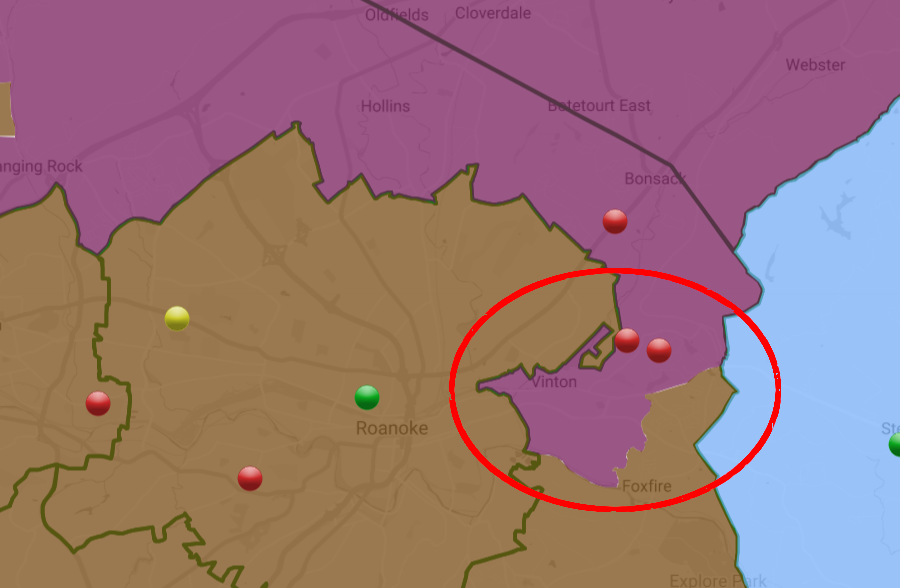
the draft proposal from the Special Masters drew comments objecting to including Vinton in a State Senate District separate from Roanoke city and county
Source: Supreme Court of Virginia, Special Masters' Proposed Senate Districts Map (interactive)
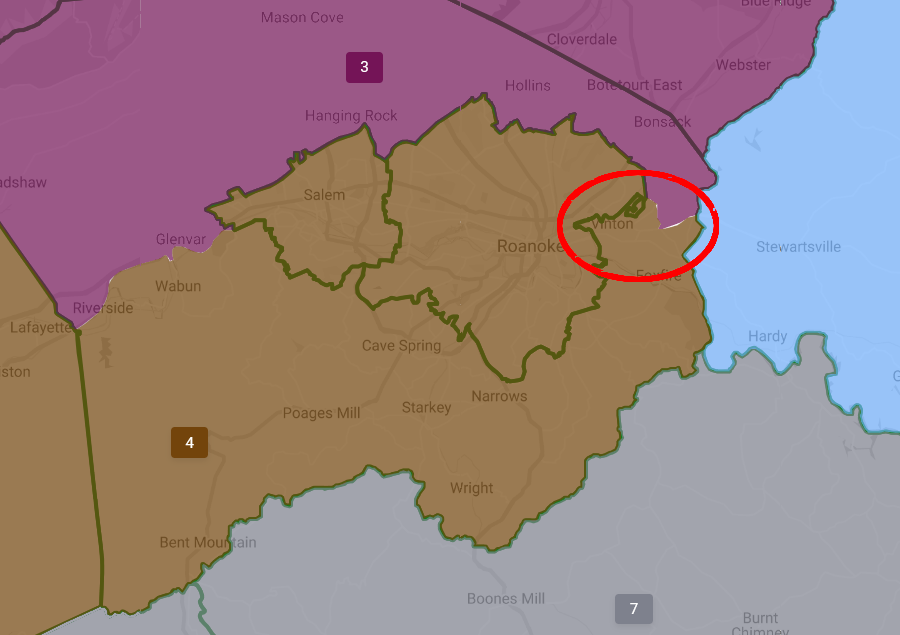
the final State Senate map placed Vinton with the City of Roanoke and Roanoke County
Source: Supreme Court of Virginia, SCV Final State Senate Map (interactive)
The court required immediate implementation of the new redistricted boundaries for future scheduled elections, starting with primary elections in 2022. An exception was made for about six months in 2022, when special elections might be required prior to the first scheduled primary elections.
The State Board of Elections was authorized to choose whether a special election would use the "old" district boundaries or the new maps adopted in December 2021 by the Supreme Court of Virginia. That flexibility legitimized the upcoming election scheduled on January 11, 2022 for the 89th District in the House of Delegates, where the incumbent had chosen to resign in December after just being re-elected in November.28
That flexibility for special elections legitimized the upcoming election scheduled on January 11, 2022 for the 89th District in the House of Delegates. The incumbent had resigned in December, just after being re-elected in November. Before the Supreme Court of Virginia adopted final redistricting maps, House Speaker Eileen Filler-Corn issued a writ of election for January 11, 2022.
The "old" boundaries were used to determine eligibility to vote in that special election, and also eligibility to be a candidate. In the hastily-arranged firehouse caucus of the Democratic Party, there were questions regarding whether two of the three candidates lived as required by state law within the 89th District boundaries. One had run in June, 2021 for the 79th House of Delegates seat in Portsmouth, while the other had just voted in Chesapeake. Both claimed they were now living within the current boundaries of the 89th District, but the third candidate easily won the nomination.29
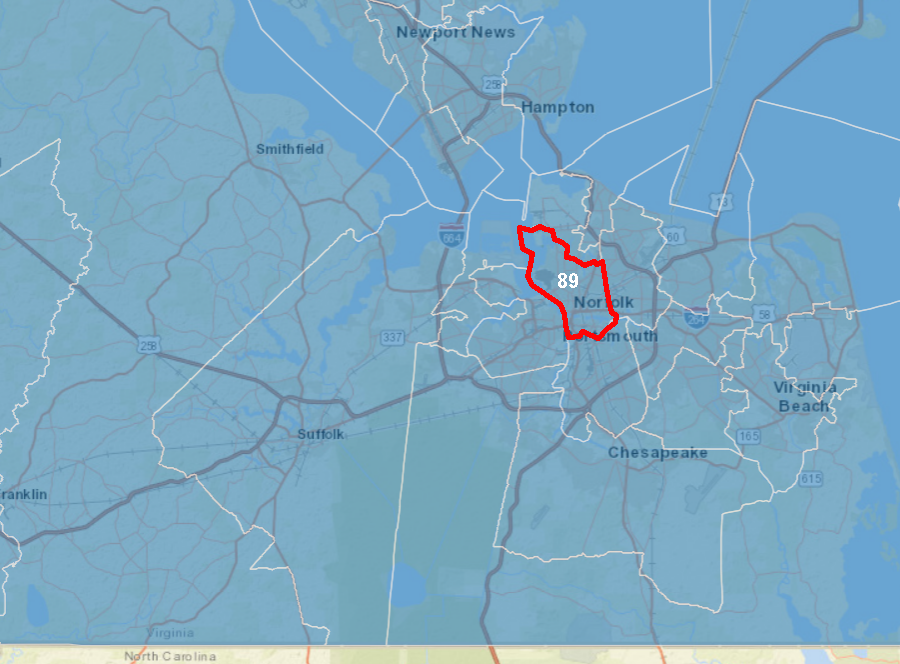
89th House of Delegates district boundaries, as used for special election on January 11, 2021
Source: Virginia Department of Transportation (VDOT), Virginia Roads
The Virginia Supreme Court decision to adopt new maps was not the final word in the 2021 redistricting process. In April 2022, a former head of the Virginia Democratic Party filed a lawsuit asking that a Federal court require a new election for the House of Delegates seats in 2022.
The 2021 election was held using the "old" boundaries established before the 2020 Census data was available, and 100 delegates were elected one month before the Virginia Supreme Court adopted new district boundaries. The Democratic activist had voted for the 68th District delegate in November 2021, but in December his residence was placed in the 78th District. He asked in his lawsuit "who is my representative?"
The lawsuit proposed the court require new elections in 2022 for the House of Delegates. Members elected in 2021 would serve just a one-year term representing the old districts, and those elected in November 2022 based on the new district boundaries would serve just a one-year term until the 2023 elections restarted two-year terms.
That proposal mimicked the solution used in 1981, when redistricting was delayed and delegates were elected using the "old" 1970 boundaries. The suit made no mention of a new election for State Senate, whose 40 members were scheduled to serve until 2023 based on the "old" district boundaries in place when they were elected in 2019. Similarly, the 1982 special election was held for just members of the House of Delegates.
The lawsuit was processed very slowly, and not until June 2022 did the Federal judges make a final ruling. They declined to order a special 2022 election, in part because the plaintiff had failed to identify "individualized disadvantage" and in part because the timing would require excessively-fast primaries and election campaigns.30
That decision left intact a redistricting map which, by one calculation, created 5 competitive districts for the 40-member State Senate and 14 for the 100-membr House of Delegates. "Competitive" was defined as having candidates win just between 47-54% of the vote in recent elections. That number of compitive districts easily created the potential for political control of either house to flip in the 2023 election.31
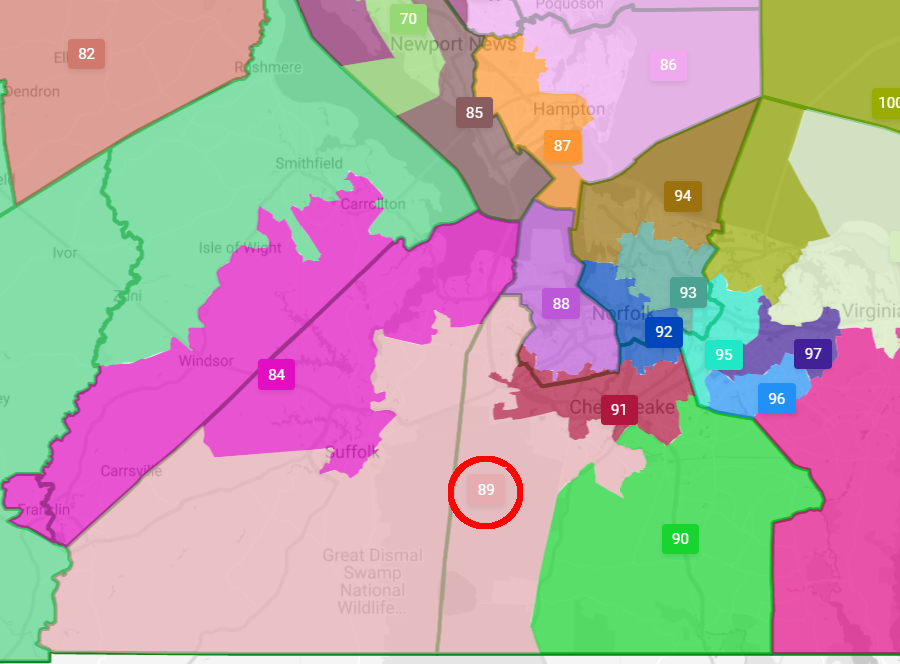
89th House of Delegates district boundaries, as determined after final 2021 redistricting
Source: Supreme Court of Virginia, SCV Final House of Delegates Map (interactive)
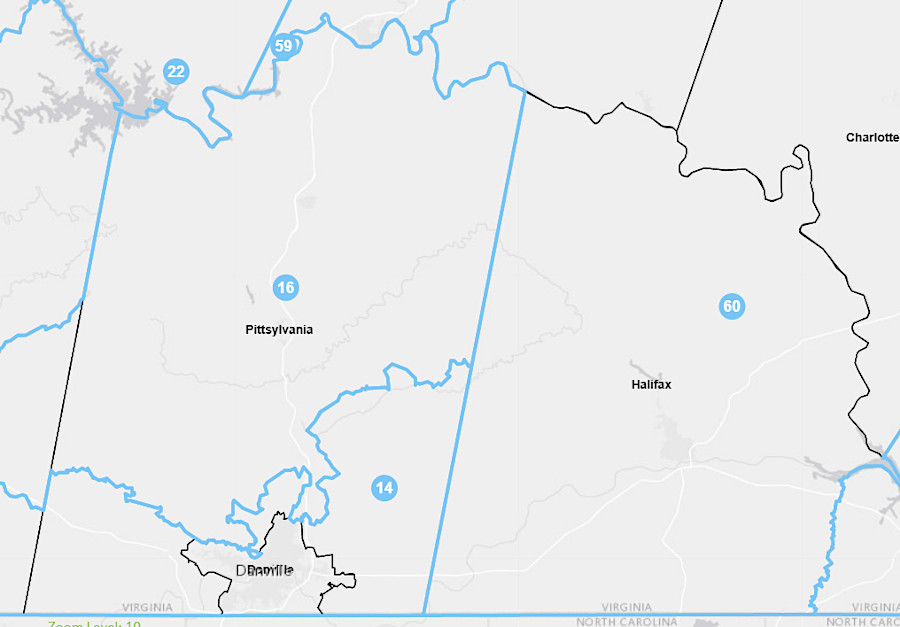
before the 2021 redistricting, Halifax County was completely within one House of Delegates district and Pittsylvania County was divided among two
Source: Virginia Redistricting Commission, House (HB5005 Passed 4/28/11)
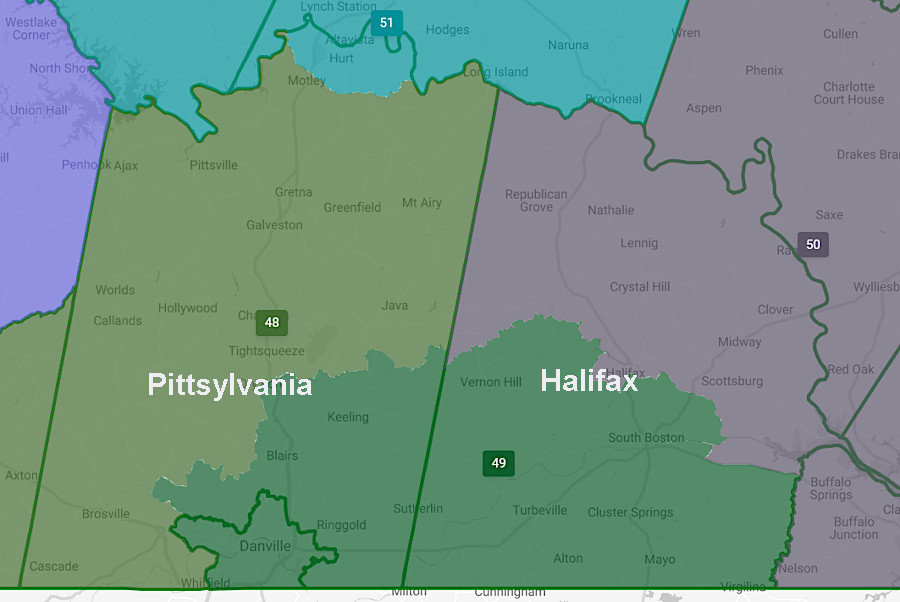
after the 2021 redistricting, Halifax County was split into two House of Delegates districts and Pittsylvania County was divided among three
Source: Supreme Court of Virginia, SCV Final House of Delegates Map (interactive)